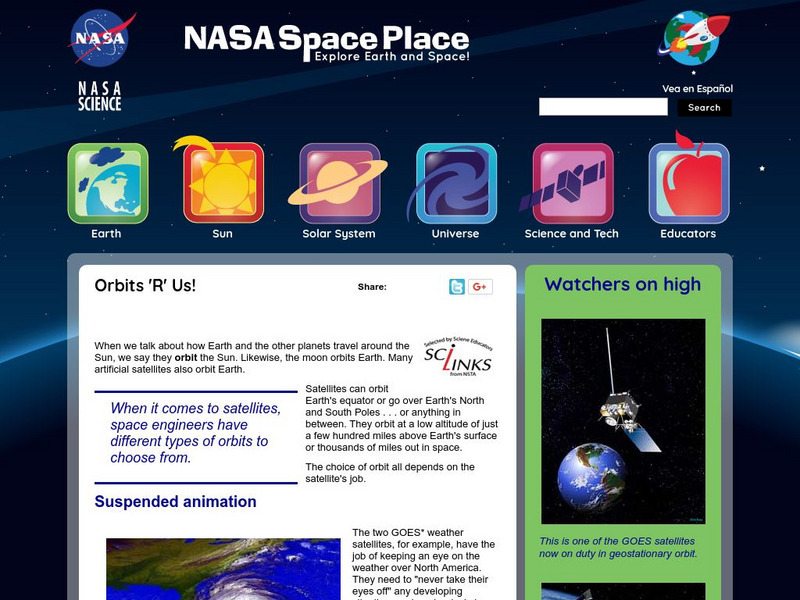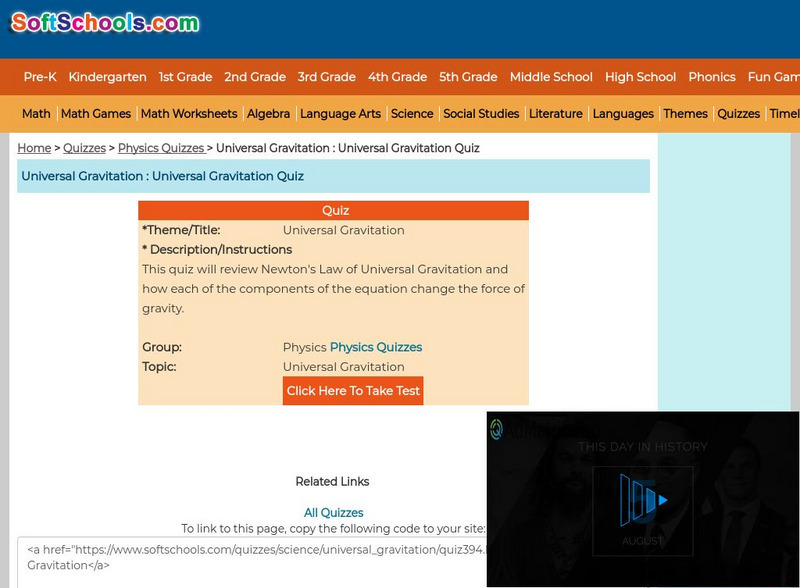Concord Consortium
The Concord Consortium: Molecular Workbench: A Pendulum
Change the mass of a suspended object to see how its movement and forces are affected by gravity.
Read Works
Read Works: Famous Scientists Sir Isaac Newton
[Free Registration/Login Required] This passage is a short biography of Sir Isaac Newton and his discovery of the force of gravity. This passage is a stand-alone curricular piece that reinforces essential reading skills and strategies...
Exploratorium
Exploratorium: Science Snacks: Hand Held Heat Engine
Can you defy the force of gravity by making liquid in a toy rise and fall without turning it over? This experiment will show you how to use hand boiler that uses temperature and pressure to move liquid into the top chamber.
Khan Academy
Khan Academy: Start: How Do Computers Simulate the Motion of Virtual Particles?
In this lesson we'll explore how we use fairly simple physics to draw particles which move according to the forces we feel in the real world (such as wind & gravity).
Science and Mathematics Initiative for Learning Enhancement (SMILE)
Smile: The Center of Mass
This site from the Illinois Institute of Technology provides a lab activity in which students determine the location of the center of mass of an irregularly shaped object. Observations are related to the balancing point of the object....
Exploratorium
Exploratorium: Skateboard Science
This site is on the science and art of skateboard design, including equipment, tricks, glossary of terms, and a live webcast of a skateboard performance.
TED Talks
Ted: Ted Ed: How Does Work, Work?
In this video, Peter Bohacek explains the interplay between work and power and how it can be seen in the functioning of a clock. [4:31] Followed by a short quiz and a list of additional resources to explore.
NASA
Nasa: The Space Place: Orbits 'R' Us
Learn about how Earth orbits the sun and how satellites orbit the Earth. Discover the different types of satellites such as GOES and POES and what they are used to monitor.
PBS
Pbs Nova: Relativity and the Cosmos
This well-written explanation of relativity includes animations and pictures which may be helpful in understanding a tough topic.
Math Science Nucleus
I. Science Ma Te: Integrating Science, Math and Technology
This site offers a wealth of online textbook-related materials that encourage the discovery of science in the world around us. Enter the site to access material on specific topics. Each section contains reading material (complete with...
Other
Fermi National Accelerator Lab: Discovery of Top Quark
This article announces the discovery of the top quark and its significance in particle physics.
Cosmo Learning
Cosmo Learning: Ocean Currents
The atmosphere forces the ocean in three ways: addition and removal of heat, precipitation and evaporation, and wind stress. The former two processes influence the density of sea water. Gravity acts on these density differences to cause...
Georgia State University
Georgia State University: Hyper Physics: Earth Orbit Velocity
A discussion and statement of an equation for orbital speed. An interactive JavaScript form allows the user to investigate the relationship between orbital height and orbital speed. A very good opportunity to practice and receive...
Soft Schools
Soft Schools: Physics Quizzes: Universal Gravitation
Assess your understanding of Newton's Universal Law of Gravitation with this interactive multiple choice quiz. Immediate feedback is provided.
NASA
Nasa: Kepler and His Laws
This site from NASA provides biographical details about the lives of Tycho Brahe and Johannes Kepler. Discusses Kepler's successes at developing laws of planeatry motion. States the three laws and discusses each one individually....
Other
Steve Spangler Science: Soda Bottle Prank
This resource demonstrates atmospheric pressure using a soda bottle and water.
Exploratorium
Exploratorium: Your Age on Other Worlds
Enter your birthday and find out how old you are on the other planets in the Milky Way Galaxy. Understand why our age is different on each planet.
Physics Classroom
The Physics Classroom: Energy Relationships for Satellites
The orbits of satellites are described and an energy analysis is performed. Kinetic, potential and total mechanical energy are explained and applied to the motion of satellites.
University of St. Andrews (UK)
University of St. Andrews: General Relativity
A somewhat labored but thorough explanation of general relativity, beginning with Aristotle. Many links to the personalities connected to the article.
Other
Personal: The Laws of Motion
This personal site explains the physics of angular momentum and their application to flight. Part of a much larger site on the procedures, principles, and perceptions of flight.
Curated OER
Hyper Physics: Earth Orbits
An equation for the law of universal gravitation is stated. The weight equation (W=m*g) is related to the law. An interactive Javascript form allows the user to practice determining the force of gravity and the acceleration of gravity...
Curated OER
Hyper Physics: Earth Orbits
An equation for the law of universal gravitation is stated. The weight equation (W=m*g) is related to the law. An interactive Javascript form allows the user to practice determining the force of gravity and the acceleration of gravity...
Curated OER
Father of Modern Experimentation and Reeko's Greatest Hero
This site provides instructions for a demonstration illustrating the "mystical force called gravity that pulls everything on Earth downward."
Georgia State University
Georgia State University: Hyper Physics: Circular Orbit
The necessity of gravitation to a circular orbit is discussed and equations for the orbital speed are derived from the law of universal gravitation. Binary systems in which two objects orbit about a center of mass are explained and...

















